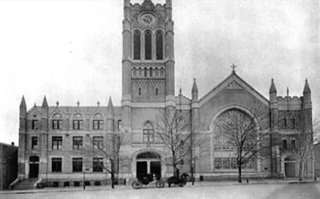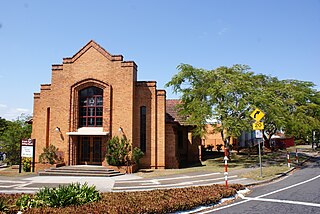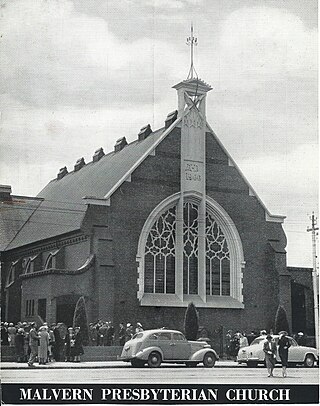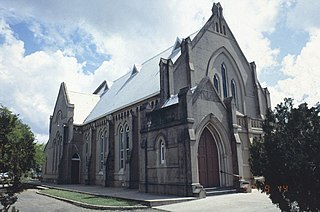
St Andrew's Presbyterian Church is a Presbyterian church at 32 Moon Street, Wingham, New South Wales, Australia. Together with St Thomas' Presbyterian Church, Krambach, the St Andrew's congregation forms part of the Wingham and Upper Manning Parish.
Australian non-residential architectural styles are a set of Australian architectural styles that apply to buildings used for purposes other than residence and have been around only since the first colonial government buildings of early European settlement of Australia in 1788.

Brindley & Foster was a pipe organ builder based in Sheffield who flourished between 1854 and 1939.

St Andrew's-by-the-Green is an 18th-century category-A-listed former church in Glasgow, Scotland. A Qualified Chapel, it was the first Episcopalian church built in the city. It is situated on the corner of Turnbull Street and Greendyke Street, overlooking Glasgow Green, on the edge of the city's East End.

The congregation of North Presbyterian Church, at 525 West 155th Street in Manhattan, New York City, is a combination of three former congregations: North Presbyterian Church, Washington Heights Presbyterian Church, and St. Nicholas Avenue Presbyterian Church.

St Andrew's Uniting Church is a heritage-listed Uniting church at 131 Creek Street, Brisbane CBD, City of Brisbane, Queensland, Australia. It was designed by George David Payne and built in 1905 by Alexander Lind & Son. Initially St Andrew's Presbyterian Church, it became part of the Uniting Church following the merger of the Presbyterian, Methodist and Congregational Churches in 1977. It was added to the Queensland Heritage Register on 21 October 1992.

The St Lucia Uniting Church is a heritage-listed Uniting church at 7 Hawken Drive, St Lucia, City of Brisbane, Queensland, Australia. Built in 1952, it was designed by Ronald Martin Wilson. The church, formerly known as St Lucia Presbyterian Church, was originally commissioned for the St Lucia congregation of Presbyterians, subsequently becoming the property of the Uniting Church. This church was the first substantial commission awarded to R. Martin Wilson after World War II. The church is listed on the Brisbane Heritage Register.

Holyman House is an iconic Art Deco building in the central business district of Launceston, Tasmania, Australia.

Hagley is a rural locality and town in the local government area of Meander Valley in the Launceston region of Tasmania. The locality is about 5 kilometres (3.1 mi) north-east of the town of Westbury. The 2016 census has a population of 335 for the state suburb of Hagley.

Malvern Presbyterian Church is located in Victoria, Australia. Opened in 1886, it was the first Presbyterian Church to be founded in the City of Malvern and is now within Stonnington, a metropolitan area of Melbourne.

Scots Church is a Uniting church on the southwest corner of North Terrace and Pulteney Street in Adelaide, the capital city of South Australia. Founded by the Free Church of Scotland, the stone church was one of the early churches built in the new city in 1850, built as the Chalmers Church.

Prince's Square is a park in Launceston, Tasmania, Australia. Established in 1858 from a disused brickfield it is now an important part of cultural life in Launceston and also a heritage park. The park is known for its symmetrical planning and the bronze gilded Val d'Osne Fountain. The park is bound on all four sides by Elizabeth Street, St John Street, Frederick Street and Charles Street.

St Mary's Cathedral in Hobart, Tasmania, Australia, is the seat of the Roman Catholic Archbishop of Hobart, presently Julian Porteous.

St Andrew's Presbyterian Church is a heritage-listed former Presbyterian church at 280 Bolsover Street, in the central business district of Rockhampton, Rockhampton Region, Queensland, Australia. The former church was designed by Voller & Graham in the Gothic Revival style and built from 1893 to 1926. The former church was added to the Queensland Heritage Register on 21 October 1992.

Clayton Wesley Uniting Church, formerly Clayton Congregational Church, is a Uniting church, located at 280 Portrush Road, Beulah Park, Adelaide, South Australia, Australia. The current building with its tall spire was built was built in 1883, although an earlier building, behind the present church and now known as the Lecture Hall, was built in 1856. The church is located in a commanding position at the eastern end of The Parade, Norwood.

John Gardner was a Scots-born Presbyterian minister in Adelaide, South Australia, the first incumbent of Chalmers Free Church of Scotland, now Scots Church, North Terrace, Adelaide. He later served at Launceston, Tasmania and Queenscliff, Victoria.

The Church of the Apostles is a Catholic church in Launceston, Tasmania, belonging to the Archdiocese of Hobart.

St Andrew's Orthodox Church is an Orthodox church located in the Southside, Edinburgh, Scotland. Edinburgh's Orthodox community was founded in 1948 and has, since 2013, occupied the former Buccleuch Parish Church, which was founded as a chapel of ease of St Cuthbert's in 1756 and closed in 1969.
East Gore Presbyterian Church is a former Presbyterian church located in Gore, New Zealand. It is located on a bluff overlooking the eastern side of the Mataura River.

Christ Church and Milton Hall are adjacent 19th-century buildings with significance in the early religious and secular history of Launceston, Tasmania. Both buildings are located on Frederick Street, near Prince's Square.





















